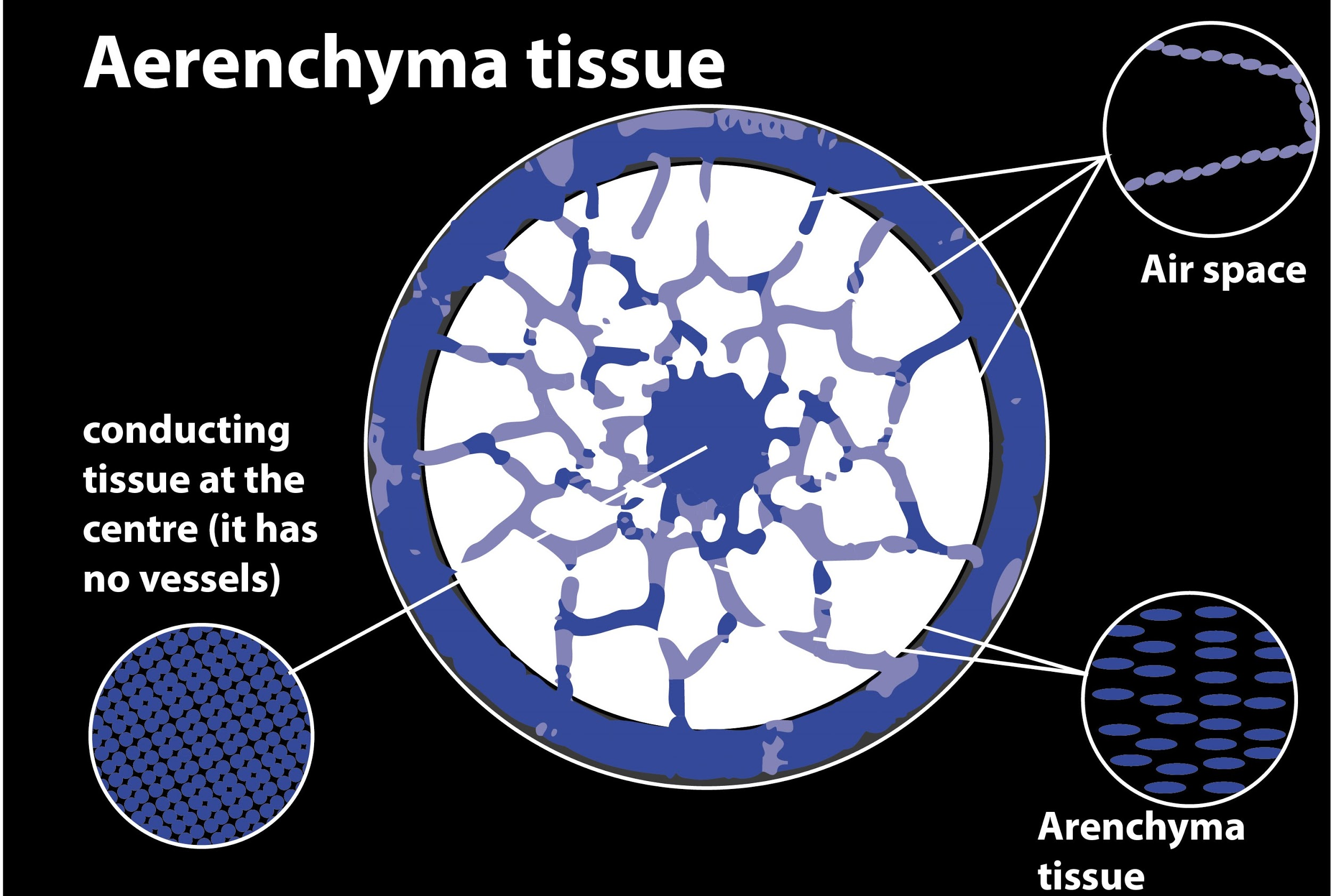
Which of the following is modified to form air cavities in aquatic plants?
(a)Aerenchyma
(b)Sclerenchyma
(c)Collenchyma
(d)None of the above
Answer
576.9k+ views
Hint: A specialized spongy permanent tissue is a characteristic feature of aquatic plants present in their different parts for the purpose of the gaseous exchange having air in their cells.
Complete answer:
The aerenchyma tissues are the sponge-like tissues that create air channels in the leaves, the stem of the plants, and allow gases to transport.
Additional Information:
-The aerenchyma tissues are a type of parenchymatous tissue that is a permanent tissue in plants.
-The main function of the parenchymatous tissue is to store food and provide nutrition to the plant parts.
-The parenchyma tissue is of two types: parenchyma and chlorenchyma.
-The aerenchyma tissue is the characteristic feature of the aquatic plants providing buoyancy to the plants which below them to float, and also helps in the exchange of gases for respiration.
-The chlorenchyma tissues consist of a number of chloroplasts which help the plant in performing photosynthesis.
-When the plants are deeply submerged under the water, this aerenchyma tissue will provide a passage for the entrance of the gases inside the plant.
-They help the plant to become resistant against various chemicals, ions, and salts.
-These issues are found generally in the hydrophytes and the wetlands.

So, the correct answer is ‘Aerenchyma’.
Note: The word parenchyma was derived earlier from the Greek word but later was derived from the Latin word parenkhein, meaning ‘visceral flesh', or ‘to pour'. Parenchyma was classified as plant tissue by Nehemiah Grew. The other permanent tissues of plants are sclerenchyma which gives strength and mechanical support to the plants, and collenchyma which gives hardness and rigidity to the plant cells. Collenchyma is a lignified tissue having a coating of lignin.
Complete answer:
The aerenchyma tissues are the sponge-like tissues that create air channels in the leaves, the stem of the plants, and allow gases to transport.
Additional Information:
-The aerenchyma tissues are a type of parenchymatous tissue that is a permanent tissue in plants.
-The main function of the parenchymatous tissue is to store food and provide nutrition to the plant parts.
-The parenchyma tissue is of two types: parenchyma and chlorenchyma.
-The aerenchyma tissue is the characteristic feature of the aquatic plants providing buoyancy to the plants which below them to float, and also helps in the exchange of gases for respiration.
-The chlorenchyma tissues consist of a number of chloroplasts which help the plant in performing photosynthesis.
-When the plants are deeply submerged under the water, this aerenchyma tissue will provide a passage for the entrance of the gases inside the plant.
-They help the plant to become resistant against various chemicals, ions, and salts.
-These issues are found generally in the hydrophytes and the wetlands.

So, the correct answer is ‘Aerenchyma’.
Note: The word parenchyma was derived earlier from the Greek word but later was derived from the Latin word parenkhein, meaning ‘visceral flesh', or ‘to pour'. Parenchyma was classified as plant tissue by Nehemiah Grew. The other permanent tissues of plants are sclerenchyma which gives strength and mechanical support to the plants, and collenchyma which gives hardness and rigidity to the plant cells. Collenchyma is a lignified tissue having a coating of lignin.
Recently Updated Pages
Master Class 12 Business Studies: Engaging Questions & Answers for Success

Master Class 12 Economics: Engaging Questions & Answers for Success

Master Class 12 English: Engaging Questions & Answers for Success

Master Class 12 Maths: Engaging Questions & Answers for Success

Master Class 12 Social Science: Engaging Questions & Answers for Success

Master Class 12 Chemistry: Engaging Questions & Answers for Success

Trending doubts
What is meant by exothermic and endothermic reactions class 11 chemistry CBSE

Which animal has three hearts class 11 biology CBSE

10 examples of friction in our daily life

One Metric ton is equal to kg A 10000 B 1000 C 100 class 11 physics CBSE

1 Quintal is equal to a 110 kg b 10 kg c 100kg d 1000 class 11 physics CBSE

Difference Between Prokaryotic Cells and Eukaryotic Cells




